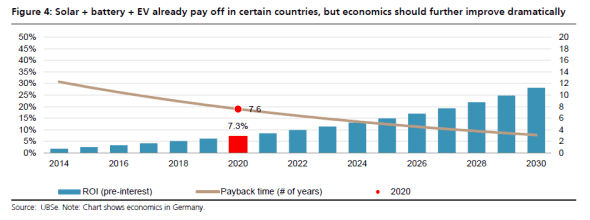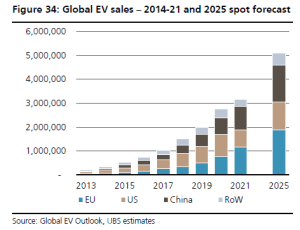 |
| Reviews and Templates for Expression We |
UBS: Time to join the solar, EV, storage revolution
Leading investment bank UBS says the payback time for unsubsidised investment in electric vehicles plus rooftop solar plus battery storage will be as low as 6-8 years by 2020 – triggering a massive revolution in the energy industry.
“It’s time to join the revolution,” UBS says in a note to clients, in what could be interpreted as a massive slap-down to those governments and corporates who believe that centralised fossil fuel generation will dominate for decades to come.
UBS, however, argues that solar panels and batteries will be disruptive technologies. So, too, will electric vehicles and storage.
By the end of the decade, it says, the combination of will deliver a pay-back time of between six to 8 years, as this graph below shows. It will fall to around 3 years by 2030. Right now, the payback is probably around 12 years, enough to encourage the interest of early adopters. You can read more here on Why EVs will make solar viable without subsidies.
The UBS report is focused on Europe, where it says that Germany, Spain, and Italy will be leaders because of their high electricity and fuel costs. But it could equally apply to Australia, which has both high electricity and high fuel costs, and a lot more sun – so solar is much cheaper.
UBS forecasts that EVs and plug-in hybrid will account for around 10 per cent of the market in Europe by 2025. “While the initial growth should predominantly be driven by incentives and carbon regulation, the entry into the mass market should happen because EVs will pay off,” it says.
“The expected rapid decline in battery cost by (more than) 50 per cent by 2020 should not just spur EV sales, but also lead to exponential growth in demand for stationary batteries to store excess power. This is relevant for an electricity mix with a much higher share of (volatile) renewables.”
In this decentralised electricity world, UBS says, the key utilities’ assets will be smart distribution networks, end customer relationships and small-scale backup units.
Those utilities that are able to move with the times – and the technologies – should be able to extract more value in (highly competitive) supply activities, as customer needs will be more complex.
Those that favour the past face impending doom.
“Large-scale power generation, however, will be the dinosaur of the future energy system: Too big, too inflexible, not even relevant for backup power in the long run,” UBS writes.
The timing of the report is noteworthy, given that what used to be Australia’s cleanest and greenest energy utility, AGL Energy, on Wednesday doubled its bet on coal remaining the dominant fuel in a centralised system. The Abbott government, meanwhile, is betting the whole Australian economy on a similar assumption.
UBS says centralised fossil fuel generation will become “extinct” – and it will happen a lot sooner than most people realise.
“Our view is that the ‘we have done it like this for a century’ value chain in developed electricity markets will be turned upside down within the next 10-20 years, driven by solar and batteries.
“As a virtuous circle, lower battery cost will also spur EV sales, which should bring further economies of scale to batteries, also for stationary applications. Power is no longer something that is exclusively produced by huge, centralised units owned by large utilities.
“By 2025, everybody will be able to produce and store power. And it will be green and cost competitive, ie, not more expensive or even cheaper than buying power from utilities.
“It is also the most efficient way to produce power where it is consumed, because transmission losses will be minimised.
“Power will no longer be something that is consumed in a ‘dumb’ way. Homes and grids will be smart, aligning the demand profile with supply from (volatile) renewables.”
This will put enormous pressure on utilities and centralised generators.
“The closer utilities are to the electricity user (both residential and commercial/industrial), the better they should fare in a decentralised electricity system,” the analysts write.
“We think large-scale power plants are the structural losers from this trend, as they are too big and most of them are too inflexible. ”
It predicts that most large scale centralised plants could be gone within a decade. “Not all of them will have disappeared by 2025, but we would be bold enough to say that most of those plants retiring in the future will not be replaced.”
And it torpedoes the theory that the retirement of some more expensive plants (the merit order effect) will cause a rebound in wholesale prices. “The last survivors will be the low-marginal-cost plants ,” it says. “We believe that what is perceived as an ‘optionality’ in conventional power generation by some investors will never materialise.
“Large-scale power stations could be on a path to extinction.”
|
|
|
|
Copyright 2011 Energy and Technical Services Ltd. All Rights Reserved. Energyts.com |

